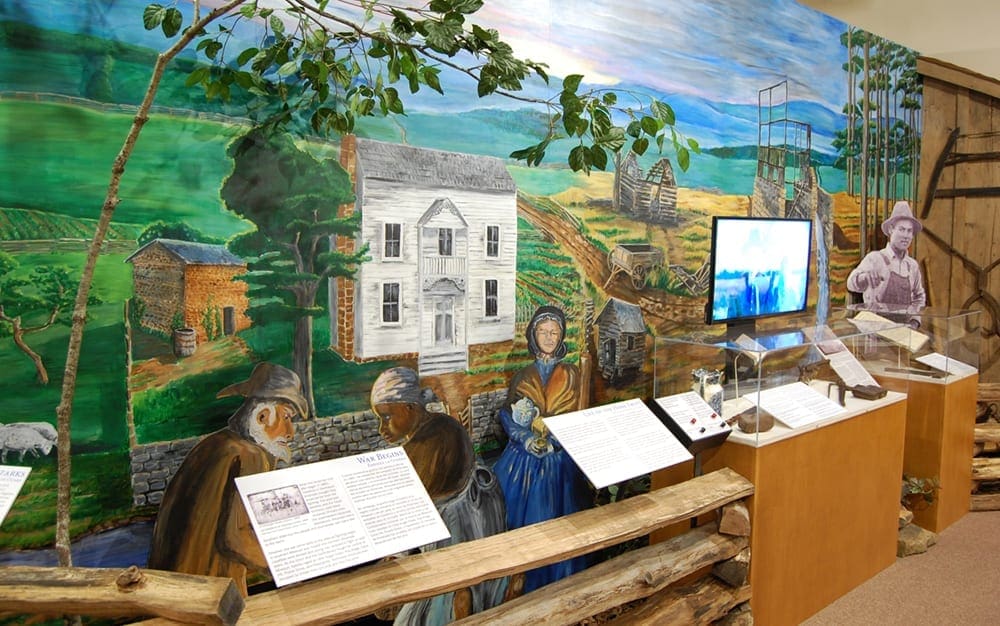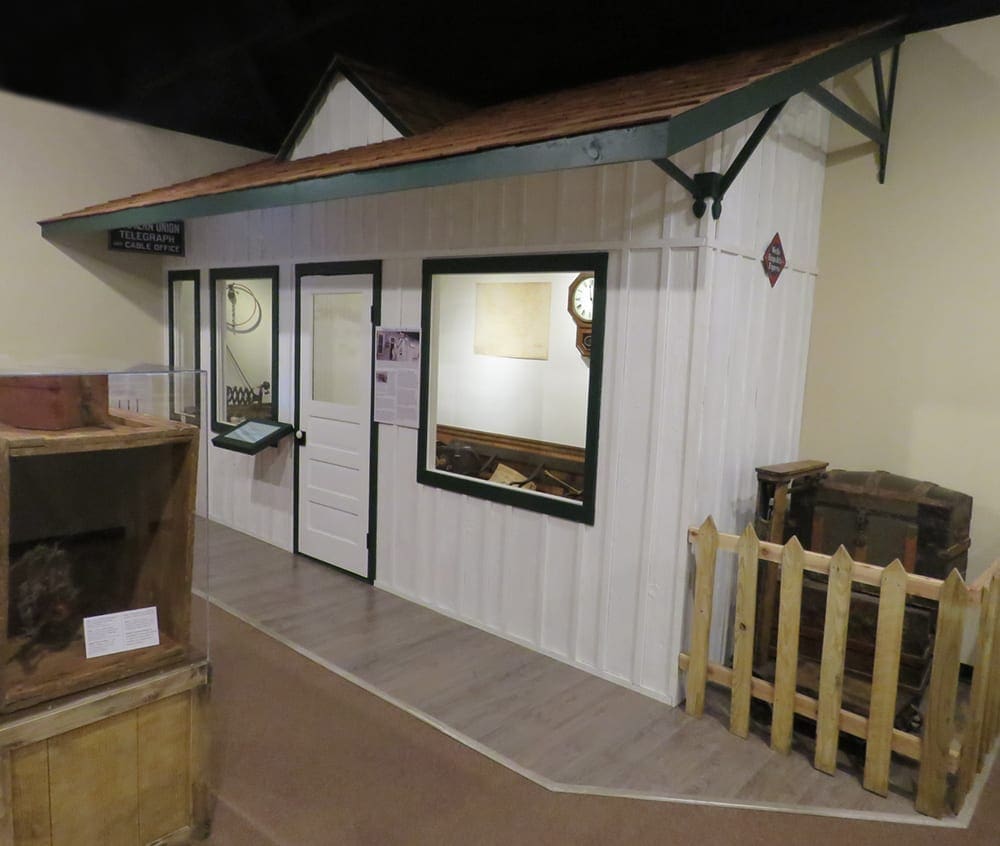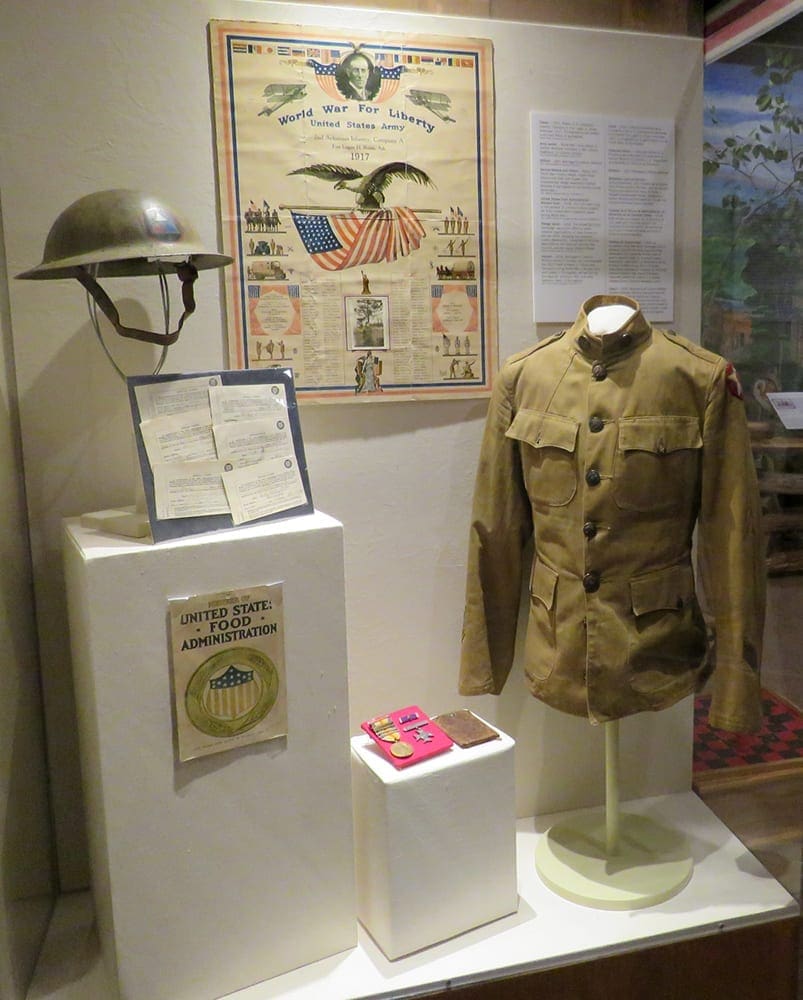Civil War to World War I
Core ExhibitIn the 1850s, Northwest Arkansas was growing and prospering. Settlers were arriving and building communities of churches, schools, and businesses. Though the region was somewhat isolated in the Ozark Mountains, John Butterfield’s Overland Mail Company stagecoach line connected the communities to the country.
When the Civil War began in 1861, residents in Northwest Arkansas thought they would be far from the fighting. However, the war came early to the area as fighting began in southern Missouri and moved into northern Arkansas. Loyalties were divided and young men enlisted to fight on both sides. Occupying armies, bushwhackers, and jayhawkers scrounged the land for food and firewood, leaving the dead and wounded in their wake. Lawlessness was the rule of the day.

Northwest Arkansas residents were forced to adapt to survive. Most young men had gone to war, while men too old to fight became targets of violence. Women and enslaved Africans were often responsible for keeping the family alive. Some citizens left the area for their own safety and the safety of their families, enslaved people, and property.
After the war, much in the area had been destroyed and some families never returned after fleeing. Others began to rebuild their former homesteads. Some soldiers from both sides who had seen the bountiful Arkansas Ozarks decided to make it their new home. Among other businesses, mills for grinding wheat and corn, for sawing lumber, and for spinning wool were built or rebuilt. Peter Van Winkle’s steam-driven sawmill prospered before the war using the labor of eighteen enslaved people. Once the war was over, Van Winkle rebuilt, hiring people he formerly enslaved—now freedmen—to work the mill.
Reconstruction in Arkansas (1867-1874) created a boom in the lumber industry as people rebuilt what had been destroyed. After the state legislature accepted the terms of the Morrill Land Grant Act, Fayetteville citizens raised $30,000 and donated four hundred acres of land to win the bid for and build a state university, now known as the University of Arkansas.
Railroads and Good Roads
 By the 1870s and 1880s, the St. Louis-San Francisco (Frisco) Railway, having begun major railroad expansion, connected Missouri to Texas by going through Northwest Arkansas. The hardwood forests in the Ozarks and the labor of many men supplied more than 2,200 railroad ties per mile of track. Once rail lines were established in Northwest Arkansas, the trains were able to ship ties to other parts of the country. But the lumber industry also depleted the forests, leaving the land exposed and vulnerable to erosion.
By the 1870s and 1880s, the St. Louis-San Francisco (Frisco) Railway, having begun major railroad expansion, connected Missouri to Texas by going through Northwest Arkansas. The hardwood forests in the Ozarks and the labor of many men supplied more than 2,200 railroad ties per mile of track. Once rail lines were established in Northwest Arkansas, the trains were able to ship ties to other parts of the country. But the lumber industry also depleted the forests, leaving the land exposed and vulnerable to erosion.
Toward the end of the 1800s, bicycling became popular. Cyclists’ desire for better roads resulted in the “Good Roads Movement.” Its Arkansas branch was organized by 1896. The growth of the movement and mass production of the automobile increased community concerns over road conditions. Improved roads boosted the early trucking industry. A reliable trucking business began to decrease time-sensitive rail shipments. Families able to own an automobile preferred to be free from the railroad timetables for travel plans. The golden age of railroads in Northwest Arkansas was essentially over by 1920.
World War I
 On April 6, 1917, after Germany had sunk three American ships, President Woodrow Wilson reluctantly issued a proclamation of war. Over 3,800 young men and women from Northwest Arkansas joined the armed forces between April 1917 and October 1918. At home, patriotism was high and most citizens supported the war. Almost every family was affected in some way by the war, so there was much rejoicing when the armistice (truce) ended the war at the eleventh hour of the eleventh day of the eleventh month of 1918 and the “War to End All Wars” was over.
On April 6, 1917, after Germany had sunk three American ships, President Woodrow Wilson reluctantly issued a proclamation of war. Over 3,800 young men and women from Northwest Arkansas joined the armed forces between April 1917 and October 1918. At home, patriotism was high and most citizens supported the war. Almost every family was affected in some way by the war, so there was much rejoicing when the armistice (truce) ended the war at the eleventh hour of the eleventh day of the eleventh month of 1918 and the “War to End All Wars” was over.
Civil War

In the 1850s, Northwest Arkansas was growing and prospering. Settlers were arriving and building communities of churches, schools, and businesses. Though the region was somewhat isolated in the Ozark Mountains, John Butterfield’s Overland Mail Company stagecoach line connected the communities to the country.
When the Civil War began in 1861, residents in Northwest Arkansas thought they would be far from the fighting. However, the war came early to the area as fighting began in southern Missouri and moved into northern Arkansas. Loyalties were divided and young men enlisted to fight on both sides. Occupying armies, bushwhackers, and jayhawkers scrounged the land for food and firewood, leaving dead, wounded, and lawlessness in their wake. Northwest Arkansas residents were forced to adapt to survive. Most young men had gone to war, while men too old to fight became targets of violence. Women and enslaved Africans were often responsible for keeping the family alive. Some citizens left the area for their own safety and the safety of their families, enslaved people, and property.
After the war, much in the area had been destroyed and some families never returned after fleeing. Others began to rebuild their former homesteads. Some soldiers from both sides who had seen the bountiful Arkansas Ozarks decided to make it their new home. Among other businesses, mills for grinding wheat and corn, for sawing lumber, and for spinning wool were built or rebuilt. Peter Van Winkle’s steam-driven sawmill prospered before the war using the labor of eighteen enslaved people. Once the war was over, Van Winkle rebuilt, hiring people he formerly enslaved—now freedmen—to work the mill.
Reconstruction in Arkansas (1867-1874) created a boom in the lumber industry as people rebuilt what had been destroyed. After the state legislature accepted the terms of the Morrill Land Grant Act, Fayetteville citizens raised $30,000 and donated four hundred acres of land to win the bid for and build a state university, now known as the University of Arkansas.
Railroads and Good Roads

By the 1870s and 1880s, the St. Louis-San Francisco (Frisco) Railway, having begun major railroad expansion, connected Missouri to Texas by going through Northwest Arkansas. The hardwood forests in the Ozarks and the labor of many men supplied more than 2,200 railroad ties per mile of track. Once rail lines were established in Northwest Arkansas, the trains were able to ship ties to other parts of the country. But the lumber industry also depleted the forests, leaving the land exposed and vulnerable to erosion.
Toward the end of the 1800s, bicycling became popular. Cyclists’ desire for better roads resulted in the “Good Roads Movement.” Its Arkansas branch was organized by 1896. The growth of the movement and mass production of the automobile increased community concerns over road conditions. Improved roads boosted the early trucking industry. A reliable trucking business began to decrease time-sensitive rail shipments. Families able to own an automobile preferred to be free from the railroad timetables for travel plans. The golden age of railroads in Northwest Arkansas was essentially over by 1920.
World War I

On April 6, 1917, after Germany had sunk three American ships, President Woodrow Wilson reluctantly issued a proclamation of war. Over 3,800 young men and women from Northwest Arkansas joined the armed forces between April 1917 and October 1918. At home, patriotism was high and most citizens supported the war. Almost every family was affected in some way by the war, so there was much rejoicing when the armistice (truce) ended the war at the eleventh hour of the eleventh day of the eleventh month of 1918 and the “War to End All Wars” was over.
